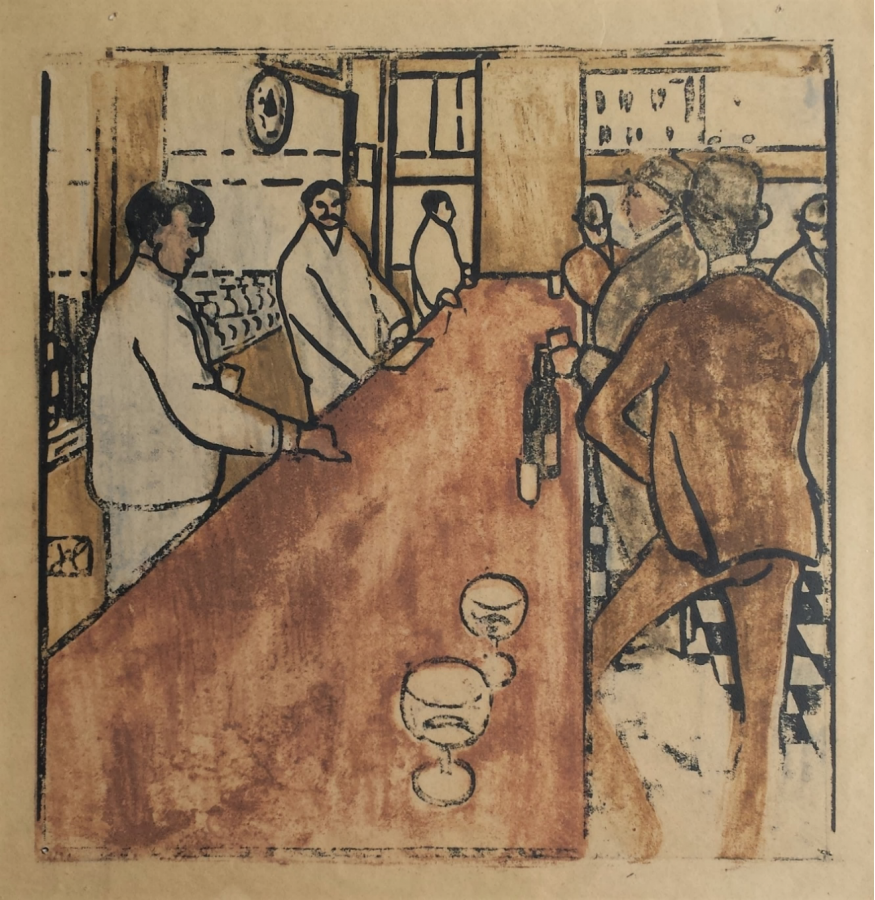'Le Bar en Pennsylvanie'
Woodcut, 195 x 195 mm. Only state. S. L. 618 bis. Monogram jel inside the plate, used here by Laboureur for the first time.
Trial proof printed on buff paper. Four tiny pinholes as registration marks, two of them at the bottom corners of the subject and the other two 10 mm above the borderline at left and right. Sheet: 320 x 245 mm. A few slight handling creases in the margins. Very good condition.
Unique known proof printed in colours by the artist.
This work remained unknown until the lineblock was found with three trial proofs in 1987 in the family’s archives. Sylvain Laboureur then wrote an article, published in Nouvelles de l’Estampe, in which he presented this unknown print: “This woodcut hadn’t been inventoried until now, and it was accompanied by three trial proofs, partially hand-coloured (...): one of them was exhibited for the first time at the Pavillon des Arts in Paris (July-September 1987). (S. Laboureur, 1987, p. 22). He also mentioned a notebook in which J.-É. Laboureur had noted, he said, "the works he had engraved at the beginning of his stay in America, where he arrived at the end of 1903". And he added: “The first page contains this description: « Le Bar, bois au canif, en couleurs, 1904 : août. Quelques épreuves d’essai. » ["The Bar, woodcut carved with a knife, in colours, 1904: August. A few trial proofs"].”
In the note 618 bis of the Catalogue complet de l'œuvre de Jean-Émile Laboureur, Sylvain Laboureur specifies that the three trial proofs printed in 1904 are "the only known proofs printed by the artist", and he clarifies that they have been "enhanced with watercolour” by Jean-Émile Laboureur (S. Laboureur, 1991, p. 559). At the end of the note, he explains that Laboureur had envisioned printing the woodblock in colour:
"The three trial proofs printed by the artist in 1904 are hand-coloured by him: he had indeed planned to do another colour version. A year after the discovery of the first woodblock, we found a woodblock of the same dimensions, the carving of which had not yet been done, but on which the drawing of the first woodblock was accurately reproduced, with five colours indicated, most likely matching up with the work he planned to do on five woodblocks, or with the various printings to be made from only one." (Ibid.: p. 560)
Our proof confirms this hypothesis: unlike the proof photographed in the 1987 article, its colours were not applied by brushstroke; they were, therefore, most likely printed from the second woodblock found a year later. Furthermore, we can see the four registration holes, which made it possible to reposition the paper: two on the lower angles of the subject and two at one centimeter above the upper borderline, on the left and on the right. Sylvain Laboureur mentions five colours. We count six in this proof: a brown ocher for the counter, a light ocher for the walls, brown and gray for the customers’ clothes, pink for the faces, and a pale blue for the blouses of the servers and the reflections of daylight in the mirror and on the floor. A slight shift of the colours is noticeable on the jacket and pants of the man with his back to us, the profile of the man’s face looking to the left, the back wall, the counter and the waiters’ clothes. The identical shift of several colours suggests that they were all printed at once. In the article of Nouvelles de l’Estampe, Sylvain Laboureur explains that his father did not have the effective equipment in Pittsburgh and had to "make the trip to New York in order to print his etchings". (S. Laboureur, 1987: p. 23). It is obvious that this proof in colours was printed with basic means.
Laboureur gave up the idea of printing Le Bar en Pennsylvanie. It wasn’t because the work did not seem successful in his opinion, but probably for the same financial reasons he invokes in 1905 to explain why he quit painting: etchings, he says, "are easier to sell" (S. Laboureur, 1987: p. 23). Although he gave up the idea of printing the woodcut, the picture of Le Bar en Pennsylvanie never left his mind. The woodcut is indeed the original form of an image that would "punctuate the work of the artist for over twenty years" (ibid.). It is found in several works, using various techniques and styles. The Musée des Beaux-Arts in Nantes houses an oil painting on a 40 cm square panel which copies the woodcut and bears the same title. Sylvain Laboureur emphasizes in the 1987 article that this painting, which, according to him, dates back to 1904, "had always been stored in a good place at the successive Laboureur family estates."(Ibid.). Ten years later, Laboureur made an etching: Bar en Pennsylvanie (S. L. 134) reproducing the same composition, but in the manner of cubism he had just appropriated. He would replicate this composition yet another time, in a more classical and watered-down form, in order to illustrate the work of N. Toye and A.-H. Adair: Petits et Grands verres, published in 1927 by Au Sans pareil.
In 1988, 55 numbered impressions and 3 hors-tirages were printed to be included in a portfolio issued on the occasion of the publication of the catalogue raisonné of Jean-Émile Laboureur’s works by Sylvain Laboureur. These modern impressions bear the stamp with a crab.
References: Sylvain Laboureur, "Un bois inconnu de J.-É. Laboureur’", Les Nouvelles de l’Estampe, n°96, december 1987, pp. 22-25; Sylvain Laboureur, Catalogue complet de l'œuvre de Jean-Émile Laboureur, Neuchâtel, Ides et calendes, 1989-1991, Vol. I, Gravures et lithographies individuelles, pp. 559-560; Idem, Peintures, aquarelles et gouaches, cat. no. 45, p.50, reproduction in colours; Musée des Beaux-Arts de Nantes, Inv. : 994.2.1.P, purchased in 1994.
Price: 12 000 EUR // 14 000 USD



